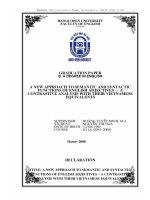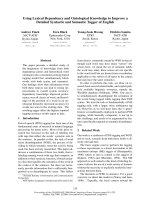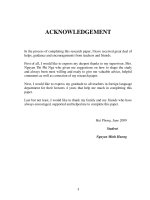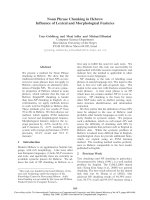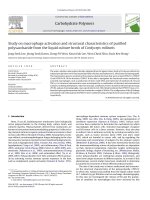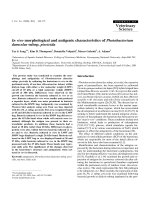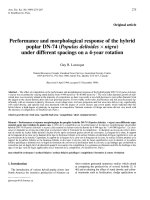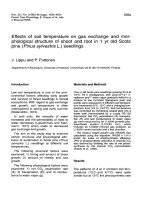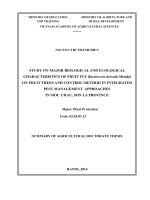lexical and morphological characteristics of english documents on information technology with implications in teaching esp at utehy
Bạn đang xem bản rút gọn của tài liệu. Xem và tải ngay bản đầy đủ của tài liệu tại đây (1.53 MB, 68 trang )
VIETNAM NATIONAL UNIVERSITY, HANOI
UNIVERSITY OF LANGUAGES AND INTERNATIONAL STUDIES
FACULTY OF POST-GRADUATE STUDIES
.....................o0o.....................
ĐẶNG THỊ LOAN
LEXICAL AND MORPHOLOGICAL CHARACTERISTICS OF
ENGLISH DOCUMENTS ON INFORMATION TECHNOLOGY
WITH IMPLICATIONS IN TEACHING ESP AT UTEHY
(Những đặc điểm về mặt từ vựng và hình thái học của tài liệu Tiếng Anh
chuyên ngành Công Nghệ Thông Tin với sự ứng dụng trong giảng dạy Tiếng
Anh chuyên ngành tại Trường ĐHSP Kỹ thuật Hưng Yên.)
M.A. MINOR PROGRAMME THESIS
Field: English Linguistics
Code: 60. 22. 15
Hanoi, 2010
ha
VIETNAM NATIONAL UNIVERSITY, HANOI
UNIVERSITY OF LANGUAGES AND INTERNATIONAL STUDIES
FACULTY OF POST-GRADUATE STUDIES
.....................o0o.....................
ĐẶNG THỊ LOAN
LEXICAL AND MORPHOLOGICAL CHARACTERISTICS OF
ENGLISH DOCUMENTS ON INFORMATION TECHNOLOGY
WITH IMPLICATIONS IN TEACHING ESP AT UTEHY
(Những đặc điểm về mặt từ vựng và hình thái học của tài liệu Tiếng Anh
chuyên ngành Công Nghệ Thông Tin với sự ứng dụng trong giảng dạy Tiếng
Anh chuyên ngành tại Trường ĐHSP Kỹ thuật Hưng Yên.)
M.A. MINOR PROGRAMME THESIS
Field: English Linguistics
Code: 60. 22. 15
Supervisor: Trần Thị Thu Hiền, MA
Hanoi, 2010
iv
TABLE OF CONTENTS
ACKNOWLEDGEMENTS ..................................................................................................... ii
ABSTRACT .............................................................................................................................. iii
LIST OF ABBREVIATIONS ................................................................................................ vii
LIST OF TABLES AND FIGURES..................................................................................... viii
CHAPTER 1: INTRODUCTION............................................................................................ 1
1.1. Rationale .......................................................................................................................... 1
1.2. Aims of the study ............................................................................................................. 2
1.3. Research questions ........................................................................................................... 2
1.4. Methods of the study ........................................................................................................ 2
1.5. Scope of the study ............................................................................................................ 3
1.6. Organization of the study ................................................................................................. 3
CHAPTER 2: LITERATURE REVIEW ............................................................................... 4
2.1. An overview of lexicon .................................................................................................... 4
2.1.1. Words and lexemes.................................................................................................... 4
2.1.2. Word classification .................................................................................................... 5
2.1.3. Word meaning ........................................................................................................... 6
2.1.3.1. Grammatical meaning ......................................................................................... 7
2.1.3.2. Lexical meaning .................................................................................................. 7
2.1.4. Word types, word tokens and word families ............................................................. 9
2.2. An overview of morphology .......................................................................................... 10
2.2.1. Basic terminology with definitions of morphology................................................. 10
2.2.2. Inflection and derivation.......................................................................................... 11
2.2.2.1. Inflection ........................................................................................................... 11
2.2.2.2. Derivation ......................................................................................................... 12
v
2.2.3. Compounding and blending .................................................................................... 13
2.2.3.1. Compounding.................................................................................................... 13
2.2.3.2. Blending ............................................................................................................ 14
CHAPTER 3: LEXICAL AND MORPHOLOGICAL CHARACTERISTICS OF EIT
TAUGHT AT UTEHY ........................................................................................................... 15
3.1. Lexical characteristics of EIT taught at UTEHY ........................................................... 15
3.1.1. Research methodology ............................................................................................ 15
3.1.1.1. Methods for lexical analysis ............................................................................. 15
3.1.1.2. Tools for lexical analysis .................................................................................. 15
3.1.1.3. Inter-rater reliability check ............................................................................... 18
3.1.2. Classification of vocabulary of the corpus of ESP texts ......................................... 21
3.1.2.1. First 2,000 most frequent words in GSL........................................................... 22
3.1.2.2. Academic word list ........................................................................................... 25
3.1.2.3. Technical vocabulary and low frequency vocabulary ...................................... 25
3.1.3. Size of technical vocabulary in the ESP texts ......................................................... 26
3.1.4. Importance of technical vocabulary in the ESP texts .............................................. 28
3.1.5. Conclusion ............................................................................................................... 29
3.2. Morphological characteristics of EIT taught at UTEHY ............................................... 29
3.2.1. Methodology............................................................................................................ 30
3.2.2. Typical inflectional suffixes in the corpora ............................................................. 30
3.2.2.1. Suffix –ing ........................................................................................................ 30
3.2.2.2. Suffix –ed ......................................................................................................... 31
3.2.3. Typical derivational affixes in the corpora .............................................................. 32
3.2.3.1. Derivational prefixes ........................................................................................ 32
3.2.3.2. Derivational suffixes ........................................................................................ 32
3.2.4. Compounding, blending and abbreviation .............................................................. 33
vi
3.2.5. Conclusion ............................................................................................................... 34
CHAPTER 4: CONCLUSIONS ............................................................................................ 35
4.1. Summary of the findings ................................................................................................ 35
4.1.1. Lexical characteristics ............................................................................................. 35
4.1.2. Morphological characteristics ................................................................................. 35
4.2. Pedagogical implications ............................................................................................... 36
4.2.1. Implications for teaching ......................................................................................... 36
4.2.2. Implications for learning ......................................................................................... 37
4.3. Limitations and suggestions for further study ................................................................ 38
REFERENCES........................................................................................................................ 39
APPENDIX ................................................................................................................................. I
vii
LIST OF ABBREVIATIONS
Abbreviations
AWL
: Academic Word List
EIT
: English for Information Technology
ESP
: English for Specific Purposes
GE
: General English
GSL
: General Service List
UTEHY
: University of Technical Education, Hung Yen
viii
LIST OF TABLES AND FIGURES
Table 1.
A rating scale for finding technical words
Table 2.
Inter-rater reliability accuracy score calculated by the number of words
assigned to four levels by the rater1 and by the researcher
Table 3.
Inter-rater reliability accuracy score calculated by the number of words
assigned to four levels by the rater 2 and by the researcher
Table 3.
Inter-rater reliability accuracy score calculated by the number of words
assigned to four levels by the rater 2 and by the researcher
Table 4.
Coverage of texts by the various levels of vocabulary tokens and types by
RANGE program
Table 5.
The most frequent words in word list 1
Table 6.
The most frequent words in word list 2
Table 7.
The most frequent words in word list 3
Table 8.
The most frequent words in word list 4
Table 9.
Size and different levels of the vocabulary throughout the corpus of texts
Table 10.
The frequency of four levels of vocabulary in the corpus
Table 11.
The most frequent derivational suffixes in the corpus
1
CHAPTER 1: INTRODUCTION
1.1. Rationale
No one denies the importance of English language in the present time as global language.
It is clear that English language has become more dominant around the world. English is a
means of communication between people of different cultures. This makes English
widespread. On the other hand, English is the language of science and technology and most
universities and institutes in the world use it in the fields of education.
In learning English, a good mastery of vocabulary is essential for learners. Without
vocabulary, it is so difficult to convey anything. Pyles and Algeo (1970) noted that ―when
we first think about the language, we think about words. It is words that we arrange
together to make sentences, conversations and discourse of all kinds‖. In fact, vocabulary
size is important to link the four skills of speaking, listening, reading and writing all
together. Clearly, for learners with specific goals, knowledge of the technical terms
associated with a particular field of the study will be necessary, and this type of vocabulary
is an obvious focal point in any examination related to lexis of the scientific texts. Indeed,
there may be a temptation to believe that a mastery of technical terms is all that is required
for success in ESP reading, in Fraser (2005).
As such, vocabulary learning and teaching is a central activity in the second language
classroom. One of the potential vocabulary learning strategies is the use of morphological
knowledge to learn vocabulary. With morphological awareness, learners are able to learn
complex words better by morphemes and morphemic boundaries.
In the context of University of Technical Education, Hung Yen (UTEHY), general English
(GE) and English for Specific Purpose (ESP) are compulsory subjects. Students of IT start
learning EIT at the beginning of the second year. Both learners and teachers are coping
with various difficulties in learning and teaching ESP, especially in technical vocabulary,
including the lack of field knowledge with numerous terms, complicated structures and
countless expressions, the insufficiency of teaching aids and reference material. Meanwhile
the teachers of ESP course need to have a thorough understanding of the nature and the
role of different categories of words such as technical words, semi-technical words,
2
academic words and how vocabularies should be taught. So far, there have not been any
researches on EIT at UTEHY.
For these reasons, the author decides to carry out the study on lexical and morphological
characteristics of English documents on Information Technology with implications in
teaching ESP at UTEHY. Hopefully, the thesis would bring concrete benefits to
researchers, teachers, and students of IT.
1.2. Aims of the study
The inter-related aims of this thesis are:
1. to find out the lexical and morphological features of IT English texts, and
2. to draw implications in teaching ESP at UTEHY.
1.3. Research questions
In order to find and analyse lexical and morphological characteristics of the texts of
English on Information Technology, the thesis raises a question:
1. What are the lexical and morphological characteristics of the texts of English on
Information Technology?
1.4. Methods of the study
The study presents a theoretical background based on a number of materials on lexicology
and morphology. Next, to achieve the aims mentioned above, quantitative and qualitative
methods appropriate to the corpus of linguistics are used with the support of some tools,
which are RANGE program (Nation, 2005), Simple Concordance Program (Reed, 19972008), and especially, Chung and Nation‘s (2003) four-point rating scale. All of them are
presented in detail in chapter 3.
3
1.5. Scope of the study
Limitations in the case of minor study mean that it is not feasible to carry out all of the
levels of linguistic analysis. The study only analyzes ten texts of EIT to find out their
lexical and morphological characteristics, because lexical and morphological features of
ESP can be analyzed under the same method with the same group of analysis tools.
However, the researcher focuses mainly on lexical features, and only general
morphological characteristics of the corpus such as inflection and affixation.
1.6. Organization of the study
The thesis consists of four chapters, references and appendices
Chapter 1:
Introduction
This chapter presents rationale, scope, and objectives of the study. Research
methods, research questions and organization of the thesis are also given
clearly in this chapter.
Chapter 2:
Literature Review
This chapter provides fundamental and theoretical concepts related to the
purpose of the study. It deals with theories of lexicon and morphology.
Chapter 3:
Lexical and morphological characteristics of English documents on
Information technology at UTEHY
This chapter not only investigates lexical items but also presents
morphological features of EIT documents used at UTEHY. Main features
of lexical and general morphological characteristics are also indicated in
this chapter.
Chapter 4:
Conclusions
This final chapter gives the overall answers for the research questions of the
study, implications for teaching and learning of ESP, especially EIT, and
some suggestions for further studies.
4
CHAPTER 2: LITERATURE REVIEW
2.1. An overview of lexicon
The terms vocabulary, lexis and lexicon are synonymous. They refer to the total stock of
words in a language (Jackson & Amvela, 2002:11). In Richards et al (1992:212), lexicon is
defined as ―a set of all the words and idiom of any language‖. The lexicon of a language is
its vocabulary, including its words and expressions. More formally, it is a language's
inventory of lexemes.
2.1.1. Words and lexemes
When linguists study the lexicon, one of the things they study is what words are. In fact,
this term appears to be a simple concept, but it is extremely difficult to have the best
definition of the word, which can satisfy all linguists. There are different definitions of
words from various authors.
In Cruse, D.A (1986: 35), word is defined as ―the smallest element of a sentence which
has the positional mobility‖ and ―they are typically the largest units which resist
interruption by the insertion of new material between their constituent parts.‖
According to Jackson and Amvela (2002:49), words are listed in dictionaries, they are
separated in writing by spaces and in speech by pauses. They consider the word as
uninterruptible unit of structure consisting of one or more morphemes and which
typically occurs in the structure of phrases.
Four main characteristics of words are also presented in Biber et al. (1999:51).
Firstly, words, phonologically, may be preceded and followed by a pause;
orthographically there are spaces of punctuation marks; syntactically, they may be
used alone as a single utterance; and finally, words, semantically, can obtain one or
more meanings in a dictionary.
The lexicon includes the lexemes used to actualize words. Lexemes are formed according
to morpho-syntactic rules and express sememes. In this sense, a lexicon organizes the
mental vocabulary in a speaker's mind: First, it organizes the vocabulary of a language
according to certain principles (for instance, all verbs of motion may be linked in a lexical
5
network) and second, it contains a generative device producing (new) simple and complex
words according to certain lexical rules. For example, the suffix '-able' can be added to
transitive verbs only, so that we get 'read-able' but not 'cry-able'.
Cruse, D.A (1986: 76), characterized a lexeme as ―a family of lexical units‖. The term
―lexeme‖ was proposed by Lyons (1977:18-25) to avoid complexities associated with the
vague word ―word‖. Let us consider these forms: go/ going/ went/ gone. Four forms have
four different meanings but they have a share lexical meaning and different grammatically
meanings. In other words, they all share a core meaning although they are spelled and
pronounced differently. We say that these four forms constitute one lexeme ―go‖. Biber et
al. (1999:54) defined lexeme as ―a group of word forms that share the same basic meaning
and belong to the same the word class‖. A lexeme may be abstract, but it can be simplified
by saying a lexeme allows different inflections to affix to it to make words. For example,
go is a lexeme, meanwhile goes and going are inflected forms of go. The dictionary
information on a lexeme as a dictionary entry generally includes its pronunciation, part of
speech, inflected forms and various meanings, generally grouped according to its senses
and sub-senses.
2.1.2. Word classification
Word-classification has been dealt with in different ways by different linguists. Part of
speech, the name employed to classify words, include nouns, verbs, adjectives, adverbs,
prepositions, pronouns, conjunctions, and interjections (oh, shh, Ouch). This classification
of the words belongs to traditional grammar and the classification of the words of a
language in this way depends on their grammatical functions. For example, nouns can
occur in certain places and have some special functions. Nouns can be the head of noun
phrases functioning as a clause constituent; subject, object or complement or it can
combine with a preposition preceded to form a prepositional phrase which can function as
subject complement and adverbial in a sentence as well as post – modifier in a noun phrase
and complementation of an adjective and a verb. So, word - class membership is an
important lexical feature. However, if we just look at a word, it is sometimes difficult to
know how to classify it. For example, the word ―book‖ may be a verb in ―book seats for
6
the theatre‖, a noun in ―I like this book‖. In some cases, a syllable stress helps us to
determine whether a word is a noun ―‘record‖ or a verb ―re‘cord‖. But, this only works for
a limit number of word pairs.
Lyons (1968: 66) used the term ―word-form‖ in word classification and classified the
words into: full and empty word-forms. Full word-forms are forms of the major parts of
speech such as nouns, adjectives, verbs and adverbs. Empty word-forms belong to a wide
variety of classes such as prepositions, articles, conjunctions, and certain pronouns and
adverbs. Other terms found in literature, more or less equivalent to ―empty word – form‖
are ―form word‖; ―functional word‖; ―grammatical word‖ and ―structure word‖. Lyons also
mentioned that in many modern schools of grammatical theory, the terms ―open and closed
classes‖ used to classify the words correlates with his terms ―full and empty word –
forms‖, respectively.
Biber et al. (1999) and Celee – Murcia and Larsen – Freemen (1983) also divided words
into open classes and closed system.
In conclusion, two classes of words: the open classes or full word forms and the close
system or empty word forms have been discussed. The closed classes contain the so-called
―grammatical‖ or ―function‖ words, which generally serve the grammatical construction of
sentences. They are articles, demonstratives pronouns, prepositions, conjunctions and
interjections. The open classes are ―content‖ words, which consist of nouns, adjectives,
verbs and adverbs, carrying the main meaning of a sentence.
2.1.3. Word meaning
Meaning of a language has been studied at different levels (from the morpheme to the
discourse). Hence, many linguists have held a discussion of the meaning of ―meaning‖, the
theories of meaning and its kinds. Word meaning is divided into two types: grammatical
meaning and lexical meaning which will be dealt with as follows:
7
2.1.3.1. Grammatical meaning
Lyons (1996:52) pointed out that "different forms of the same lexeme will generally,
though not necessarily, differ in meaning: they will share the same lexical meaning (or
meanings) but differ in respect of their grammatical meaning‖. Obviously, a meaningful
sentence is composed of smaller meaningful parts, and the smaller parts are namely
phrases or words which are in different forms causing different meanings of the sentence.
For example, the sentence ―A dog barked‖ has the different meaning from ―The dog
barked‖ or ―Some dogs barked‖ or ―A dog barked‖.
Lobner (2002: 12-13) also mentioned that the grammatical form of a word, e.g., singular,
plural, positive, comparative, simple past tense, progressive past tense, etc. has a meaning.
Such meanings are called grammatical meaning.
In conclusion, grammatical meaning of the words is meaning in terms of grammar and
their grammatical meaning only functions in contexts whereas their lexical meaning can
stand on its own. Thus, the word ―dog‖ has meaning to an English speaker, even out of
contexts, whereas ―the‖ does not. The lexical meaning and the grammatical meaning of the
word together form the meaning of the sentence.
2.1.3.2. Lexical meaning
Ferdinand de Saussure in Jackson & Amvela (2002:55) considered word meaning as a
linguistic sign – a mental unit consisting of two faces: a concept and an acoustic image. He
thinks that the discussion of word meaning focuses on the relationship between the two
faces of the sign, via the acoustic image or ―significant‖, i.e. the signifier, on the one hand,
and the concept of ―signifié‖, i.e. the thing meant, on the other. And he narrows down his
discussion to an examination of some of the most common terms associated with the word
meaning such as: denotation, connotation, reference and sense.
According to Baker (1988:12), the lexical meaning of a word or lexical unit may be
thought of as the specific value it has in a particular linguistic system. In other words,
the lexical meaning is ―the most outstanding individual property of the word‖. It can
stand on its own.
8
In short, basing on Lyons (1996) and Jackson & Amvella (2002), the lexical meaning of
the word can be classified into denotation and connotation.
a. Denotation
We are likely to think that a language consists of a large number of words and each of
these words has a direct correlation with something outside language, which is its meaning.
Thus, denotation is the linguistics term used to refer to the relation holding between a word
(a lexeme) and a whole class of extra-linguistic objects. Lyons (1977:207) defined the
denotation of a lexeme as the relationship that holds between that lexeme and persons,
things, places, properties, processes and activities external to the language system. In other
words, denotational (referential) meaning is the meaning of expression (a word), which it
refers to or denotes or stands for. For example, the word ―doctor‖ refers to the person who
works in the hospital and helps other people to recover from diseases.
Jackson & Amvela (2002:57) stated that denotation refers to the relationship between a
linguistic sign and its denotatum or referent.
b. Connotation
Crystal, D. (2003) stated that a group of synonyms cannot be distinguished by definition in
terms of their denotation, but they usually display noticeable differences of connotation, as
in the case of car, automobile, run about, buggy, banger, bus, hot rod, jalopy, old crock,
racer, and so on. According to Jackson & Amvela (2002:57), connotation constitutes
additional of lexemes, e.g. poetic, slang, baby language, biblical, casual, colloquial, formal,
humorous, legal, literary and rhetorical. Lobner (2002:35) also considered connotation the
secondary meaning in addition to the primary lexical meaning. Connotation is, in fact,
largely dependent on the context of usage of the word. Let us consider the words like ―pass
away‖; ―die‖. These words have the same descriptive meaning or denotative meaning but
the later is neutral and used in many situations whereas the former is used in formal
situation to convey the speaker‘s regret someone‘s death. So, one part of the connotation of
a lexeme is its expressive meaning (emotive, attitudinal or affective meaning), which
conveys the speakers‘ evaluation, attitudes and feeling. Another part of connotation is the
9
evoked meaning of a lexeme (stylistic meaning), which is ―a consequence of the existence
of different dialects and registers within a language‖ (Cruse, 1986:282).
In conclusion, connotation helps us to have a subtle choice of a certain words. Denotation
and connotation are both important in order to determine word meaning in a given context.
2.1.4. Word types, word tokens and word families
Let us take a look at this example:
Mary goes to Paris next week, and she intends going to Edinburgh next month.
The sentence has fourteen words placed a space between each word, but two of them (the
words to and next) are repeated. So there are only twelve different words in the sentence.
According to Carstairs-McCarthy (2002:5), there are 14 tokens and 12 types in the
sentence. One may say two performances of the same tune, two copies of the same book,
are distinct token of one type.
The type-token distinction is relevant to the notion ―word‖ in this way. Sentences (spoken
or written) may be said to be composed of word-tokens, but it is clearly not word-tokens
that are listed in dictionaries. Words are listed in dictionaries entries are, at one level,
types, not tokens.
Another term relative to the study is ―word families‖. Words are grouped into families on
the basic of their morphology, both their inflections and their derivations (Bauer and
Nation, 1993). A family consists of a base form, its possible inflectional forms and the
words derived from it by prefixation and suffixation. According to Bauer and Nation
(1993), the idea of a word family is important for a systematic approach to vocabulary
teaching and for deciding the vocabulary load of texts. A word family includes a collection
of formally related and semantically related word types. So, the agree family could include
agree, agrees, agreed, agreeing, agreement, disagree, disagreement.
10
2.2. An overview of morphology
2.2.1. Basic terminology with definitions of morphology
Morphology refers to the study of forms. Linguistics morphology refers to the study of
words, their internal structure and the mental process that are involved in word formation
(Arnoff & Fudeman, 2005; O‘Grady & Cuzman, 1997). It is ‗… the study of the
hierarchical and relational aspects of words and the operation on lexical items according to
word formation rules to produce other lexical items‘ (Leong and Parkinson, 1995, p. 237).
Bauer (1983:13) defined that ―morphology as a sub-branch of linguistics deals with the
internal structure of word-forms‖.
The basic units in morphology are morphemes. Morpheme is the smallest meaningful unit
of language (any part of a word that cannot be broken down further into smaller
meaningful parts, including the whole word itself). For example, the word 'items' can be
broken down into two meaningful parts: 'item' and the plural suffix '-s'; neither of these can
be broken down into smaller parts that have a meaning. Therefore 'item' and '-s' are both
morphemes. Katamba and Stonham (1993:24) defined that ―The morpheme is the smallest
difference in the shape of a word that correlates with the smallest difference in word or
sentence meaning or in grammatical structure‖. A morpheme may be termed free and
bound morpheme. Free-morpheme is a morpheme that can stand alone as an independent
word (e.g. 'item'). Bound morpheme is a morpheme that cannot stand alone as an
independent word, but must be attached to another morpheme/word (affixes, such as plural
'-s', are always bound).
A root is a form which is not further analyzable, either in terms of derivational or
inflectional morphology. A base form is any form to which affixes of any kind can be
added. This means that a derivationally analyzable form to which derivational affixes are
added can only be only referred to as a base, and the word part touchable can become an
analyzable base. A stem is involved only when dealing with inflectional morphology. In
this way, untouchable becomes a stem, (Bauer, 1983:20).
The analysis of words into morphemes begins with the isolation of morphs. A morph is a
physical form representing some morpheme in a language (Katamba and Stonham
11
(1993:24). A morph can be defined as a segment of a word form which represents a
particular morpheme, Bauer (1983:15).
If different morphs represent the same morpheme, they are grouped together and they are
called allomorphs of that morpheme, Katamba and Stonham (1993:26). According to
Bauer (1983:15), an allomorph is a phonetically, lexically or grammatically conditioned
member of a set of morphs representing a particular morpheme. For example, the plural
morpheme ―-s‖, in its regular forms, has three different phonological realizations: /iz/, /s/
and /z/ depending on the phonetic environment in which the morpheme occurs, i.e. it is
phonetically conditioned.
2.2.2. Inflection and derivation
As we know, morphemes can be divided into two major functional categories: derivational
morphemes and inflectional morphemes. This reflects arecognition of two principal wordbuilding (morphological) processes: inflection and derivation.
2.2.2.1. Inflection
According to Katamba and Stonham (1993:223), inflectional morphology is concerned
with syntactically driven word-formation. Inflectional morphology deals with syntactically
determined affixation processes. They also state that inflectional morphemes do not change
referential or cognitive meaning, and do not alter the word-class of the base to which it is
attached as well. Inflectional morphemes are only able to modify the form of a word so
that it can fit into a particular syntactic slot. For example, ―book” and ―books‖ are both
nouns referring to the same kind of entity. The ―–s‖ ending merely carries information
about the number of those entities.
The following inflectional suffixes are frequently used ones in English.
Suffix
Stem
Function
Example
-s
N
plural
book-s
-s
V
3rd person, singular, present tense
sleep-s
-‗s/s‘
N
genitive case of noun
Janet’s book
12
-ed
V
past tense
walk-ed
-ing
V
progressive (incomplete action)
walk-ing
-er
Adj
comparative degree
tall-er
-est
Adj
superlative degree
tall-est
(adapted from Katamba and Stonham, 1993:53)
Other forms of inflection such as the following are not frequently used:
Internal change in plurals and tenses (internal vowel change)
man/men; grow/grew
Suppletion in adjectives and tenses
good/better; go/went
Zero inflection in plurals or tenses
deer/deer; put/put
(adapted from Barnard, 2005:530)
English has no inflectional prefixes, but some other languages have both inflectional
prefixes and suffixes.
2.2.2.2. Derivation
Derivational morphology is used to create new lexical items by either:
-
modifying significantly the meaning of the base
-
to which they are attached, without necessarily changing its grammatical category,
for example, ―kind‖ and ―un-kind‖.
-
they bring about a ship in the grammatical class of a base as well as a possible
change in meaning, for example, ―hard” (Adj) and ―hardship” (N (abs))
-
or they may cause a ship in the grammatical subclass of a word without moving it
into a new word-class (as in the case of friend (N (conc)) and friendship (N (abs)).
(adapted from Katamba and Stonham (1993:49-51))
13
Meanwhile there are only inflectional suffixes, derivational morphemes are either prefixes
or suffixes.
E.g.:
Prefixes: ex-president, reread, unknown
Suffixes: childhood, centralize, greenish, derivation
Words can be built up by using a number of prefixes and suffixes for the same stem, and
may become very complex.
E.g.: pre-industr-ial, industry-ial-ise, industry-ial-is-ation
2.2.3. Compounding and blending
2.2.3.1. Compounding
Compounding is another word-building process. According to Biber et al. (1999:58), in
compounding, independently existing bases are combined to form new lexemes. Carstairs
– McCarthy (2002:59) also had the similar idea that compounds are words formed by
combining roots. These following are compound classes:
Compound verbs
Verb-verb (VV): stir-fry, freeze-dry
Noun-verb (NV): hand-wash, air-condition
Adjective-verb (AV): dry-clean, whitewash
Preposition-verb (PV): underestimate, outrun
Compound adjectives
Noun-adjective (NA): sky-high, oil-rich
Adjective-adjective (AA): grey-green, red-hot
Preposition-adjective (PA): underfull, overactive
14
Compound nouns
Verb-noun (VN): swearword, playtime
Noun-noun (NN): mosquito net, butterfly net
Adjective-noun (AN): blackboard, greenstone
Preposition-noun (PN): in-group, outpost
(adapted from Carstairs – McCarthy (2002:60-62))
2.2.3.2. Blending
As we see in compounding, the whole of each component root is reproduced. However, we
encounter a kind of compound where at least one component is reproduced only partially.
These are known as blends (Carstairs – McCarthy (2002:65). Blending is a process which
collapses two words into one.
For example: compuserve (fusing computer and serve)
computron (fusing computer and electron)
15
CHAPTER 3: LEXICAL AND MORPHOLOGICAL CHARACTERISTICS OF EIT
TAUGHT AT UTEHY
3.1. Lexical characteristics of EIT taught at UTEHY
3.1.1. Research methodology
Although there have been no researches on EIT coursebook at our school since it was first
introduced, there have been some discussions and changes of materials. 10 texts from unit
1 to unit 10 of the book Oxford English for Computing by Boeckner and Brown is
currently being taught for IT students for 36 hours of instruction in the second semester of
the second year.
To carry out the lexical and morphological analysis of the material, 10 texts of the book
must be changed into the corpus of 10 text files because of the requirement of the methods
and the tools that the researcher will use. It is necessary to give a detailed description of
these methods and tools before the analysis is performed.
3.1.1.1. Methods for lexical analysis
The lexical analysis of English of Information Technology followed the basic steps of ESP
analysis. Firstly, a quantitative method appropriate to the corpus of linguistics was used
with the support of RANGE and FREQUENCY program. The program produced
classification of words based on three word lists available in it, the levels of word types,
word tokens and word families of the corpus of texts. Depending on the classification of
words made by the program, the researcher reclassified the vocabulary into four new levels
based on the Chung and Nation‘s (2003) four-point rating scale which will be described in
more detailed in the next section. However, this technique was complemented by an
equally important qualitative method.
3.1.1.2. Tools for lexical analysis
To carry out the lexical analysis, first, RANGE program which is available at
was used to find the coverage of the texts by
certain word lists, create word lists based on frequency and range, and to discover shared
16
and unique vocabulary in several pieces of writing (Nation, P. (2005)). It is the program for
Windows based PCs made by Nation, P. to provide the statistics of word types, word
tokens, word families, frequency of occurrences and range of occurrences to get an overall
statistic description of the corpus of texts. The 2,000 most frequent words from GSL,
Academic Word list and the list of words which are not in the above lists or technical
words are made by RANGE. However, to have in-depth description of lexical
characteristics of ESP, it is necessary to apply the Chung and Nation‘s (2003) four-point
rating scale to get four new levels of vocabulary.
Chung and Nation (2004) proved four-point rating scale technique has a higher degree of
reliability than the others in identifying technical vocabulary. A rating scale approach to
identifying terms involves deciding whether the individual meanings of words fall into the
sphere of specialised meaning or not. Deciding on or interpreting the individual meanings
of words depends on the ability of the researchers to draw on their own domain knowledge
and to make inferences from domain information within the context in question (Asher and
Lascarides, (1996); Becka (1972); Stambuk (1998) in Chung and Nation (2004)). At the
decision stage, researchers ultimately have to rely on their intuition and knowledge of the
field. This approach was used with the support of RANGE program, some specialised
dictionaries, and discussions with specialised experts.
With the application of the four-point rating scale in classification of four levels of
vocabulary, words were classified as being technical or non-technical words by rating them
on a four point scale designed to measure the strength of the relationship of a word to a
particular specialised field, Chung and Nation (2003). Items classified at steps 3 and 4 in
Table 1 were considered to be technical words. Items at steps 1 and 2 were not.
Level 1 (the first 2,000 most frequent words)
Words such as function words that have a meaning that has no particular
relationship with the field of information technology, that is, words independent
of the subject matter. Examples are: the, is, between, it, your, which, by, common,
commonly, directly, constantly, early, and especially.
17
Level 2 (Academic Word List)
Words that have a meaning that is minimally related to the field of information
technology. Examples are: incidence, detect, available, distributed.
Level 3 (Technical words)
Words that have a meaning that is closely related to the field of information
technology. They refer to parts, structures, operations or functions of the
computers. Such words are also used in general language. The words may have
some restrictions of usage depending on the subject field. Examples are: access,
scan, infected, technology, crystal, voltage. Words in this category may be
technical terms in a specific field like information technology and yet may occur
with the same meaning in other fields and not be technical terms in those fields.
Level 4 (Low frequency words)
Words that have a meaning specific to the field of information technology and are
not likely to be known in general language. These words have clear restrictions of
usage depending on the subject field. Examples are: microchips, mainframe,
desktop, palmtop, drivers, Gridpad, pixel, antivirus.
Table 1: A rating scale for finding technical words (adapted from Chung
and Nation (2003))
Words at Level 3 may have polysemes that occur in general use with little change in
meaning, for example mouse and button. Level 4 includes words that even though they are
used outside information technology, they could be thought of as being information
technology terms. Examples are software and database.
To ensure the rating scale is used reliably, an inter-rater reliability check is carried out.
Inter-rater reliability check is used to estimate whether there is a reasonable degree of
agreement by different raters as to where a lexical item falls on the scale. To make sure
that the inter-rater reliability check works efficiently, the training of raters should be done
18
using the same kinds of materials that are used for the research. The way it was applied in
this study will be presented later in the following section.
3.1.1.3. Inter-rater reliability check
According to Chung and Nation (2003), to make sure that the scale could be applied
consistently in the research, an inter-rater reliability check was carried out. The researcher
invited two raters who are native speakers of English and are working at our school to
participate in the check. The raters' task was to assess the degree of specificity of the
meaning of the words in the text to the field of information technology.
The first step of the check was the training of the invited raters. The researcher explained
the objectives of the study, the aim of the reliability check and how to consider the
semantic relationship in order to place the words in the four-point scale. The raters were
then provided with the text in which the words to be rated were already marked. Forty
words (ten from each of the four steps as classified by the researcher) were randomly
chosen to be used. The researcher and the rater went through the words one by one
together. Each time the raters‘ results were compared with those of the researcher. When
discrepancies were found, they were discussed by the researcher and the raters and all
were resolved.
Then, sixty words were randomly selected from two parts of two texts, fifteen for each of
the four steps, were provided for the raters to analyze independently. All these terms are
numbered (1), (2), (3) and (4) according to the four levels of vocabulary respectively by
the researcher. However, some words appear in either Level 1 or 2, according to RANGE
program may go into Level 3, so that these words are marked with (1→3) for those moving
from Level 1 to Level 3 and (2→3) for those moving from Level 2 to Level 3.
Levels of vocabulary chosen by the researcher (from text 2)
Enter the clipboard(4) computer(2→3), a technology(2) that has been in development(1) for
the last 20 years but took hold in the mass market only this year. Clipboard PCs - which, as
their name(1) suggests(1), are not much bigger than an actual clipboard - replace(1) the
